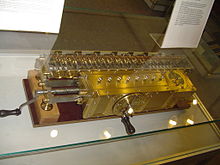Leibnizhaus (Hanover)


The Leibniz House was originally a 1499-built Renaissance - town house in Hanover , which after the philosopher Gottfried Wilhelm Leibniz is named. He lived in the house from 1698 until his death in 1716. The building was destroyed in an air raid on Hanover in 1943 during the Second World War . Between 1981 and 1983 a reconstructed new building with the faithfully reproduced facade was erected elsewhere.
history
Origin and residence of the scholar Leibniz
The house was built in 1499 as a stone building for the von Soden patrician family at Schmiedestrasse 10 and was rebuilt between 1648 and 1652 by Hinrich Alfers for the new resident, War Secretary Carol von Lüde. Above all, it was given a new facade in the Renaissance style (only a clay frieze from the previous building was taken over). The house had four main floors, the gable was again staggered into four floors. The sculptor Peter Köster created the rich sculptures on the three-story bay window. POSTERITATE ("posterity") was written above the frieze of the arched entrance .
On September 29, 1698, Hofrat Gottfried Wilhelm Leibniz, as head of the ducal library, moved into an apartment in the house, which Elector Georg Ludwig had furnished for him. Leibniz had previously lived on Leinstrasse. Since the new premises were much larger, the Electoral Library was also housed in them.
Leibniz's student and secretary, the young Rafael Levi , lived with Leibniz in his house for several years .
Leibniz died on November 14, 1716 in the room on the first floor of the bay window. Then in 1719 the library was moved to the newly built archive building (at today's Waterlooplatz ).
After Leibniz's death
The Leibnizhaus (this name became common in the second half of the 19th century) had its special "consecration" not only because it was considered one of the oldest and most beautiful houses in old Hanover, but also because the philosopher Gottfried Wilhelm Leibniz lived and died here. On the second floor of the bay window, the future actor, playwright and theater director August Wilhelm Iffland was born in 1759 . He has become known as a contemporary performer of Schiller and Shakespeare heroes.
In 1797 the master baker Johann Gerhard Helmcke acquired the Leibnizhaus and sold it in 1800 for a profit of 3,300 Reichstalers .
The house was acquired by King Ernst August in 1844 and thus saved from the threat of demolition. In 1866 it became the property of the Prussian state, and in 1893 it became the museum of the Kunstgewerbeverein. Before that, Albrecht Haupt had freed it from all interim additions.
destruction
In 1943 the Leibnizhaus was destroyed by bomb explosions in an air raid during the Second World War . Today, at the former address of the Leibnizhaus, the now listed parking garage Schmiedestrasse is located .
Reconstruction and current use
In 1983 the Leibnizhaus was reconstructed elsewhere on the Holzmarkt next to the Historical Museum with a faithful facade .
Since the reconstruction, the Leibnizhaus has been used as a guest and event house for the Hanover universities and is managed by the Gottfried Wilhelm Leibniz University of Hanover . Guest scientists from all over the world live in the apartments. In the other rooms, meetings and (festive) events of the Hanoverian universities take place. Commercial use is not possible.
In a separate area of the large event room there is an exhibition about the life and work of Leibniz, including a replica of his calculating machine.
facade
The renaissance facade by the architect Wilfried Ziegemeier with sculptures by Georg Arfmann , which was recreated on the Holzmarkt between 1981 and 1983, has richly decorated paintings on the bay window. A number of biblical motifs are shown: the creation of Eve, Adam and Eve under the tree (including the watchdog), the expulsion from Paradise , Cain and Abel , Isaac's sacrifice , Jacob's dream, Venus and Cupid , Christ in Gethsemane , Judith with the head of Holofernes , the Judgment of Solomon , Samson and the Lion, David and Goliath .
Between these representations there are self-portraits by sculptors and architects; The halberd bearer on the top bears the features of the architect Jochen Steinberg from the Ziegemeier office, who was responsible for the reconstruction together with Georg Arfmann.
literature
- Arnold Nöldeke : The art monuments of the province of Hanover. 1: Hanover district. Issue 2: City of Hanover. Part 1: Monuments of the "old" city area of Hanover. Hanover 1932. Reprint: Wenner, Osnabrück 1979, ISBN 3-87898-151-1 , pp. 619–623
- Cord Meckseper : The Leibnizhaus in Hanover. The story of a monument. Schlueter, Hannover 1983, ISBN 3-87706-192-3
- Helmut Knocke , Hugo Thielen : Holzmarkt 4–6. In: Hannover Art and Culture Lexicon , p. 153f.
- Helmut Knocke: Leibnizhaus. In: Klaus Mlynek, Waldemar R. Röhrbein (eds.) U. a .: City Lexicon Hanover . From the beginning to the present. Schlütersche, Hannover 2009, ISBN 978-3-89993-662-9 , p. 393f.
Web links
- Brief description as a guest house
- Interactive 360 ° panorama photo of the Leibnizhaus and the surrounding area
Individual evidence
- ↑ Peter Schulze : Rafael Levi. In: Stadtlexikon Hannover , p. 512
- ^ Klaus Mlynek : Helmcke, Johann Gerhard. In: Dirk Böttcher , Klaus Mlynek, Waldemar R. Röhrbein, Hugo Thielen: Hannoversches Biographisches Lexikon . From the beginning to the present. Schlütersche, Hannover 2002, ISBN 3-87706-706-9 , p. 162 and others, online via Google books
- ↑ Helmut Knocke , Hugo Thielen : Schmiedestraße 13 , in Dirk Böttcher , Klaus Mlynek (ed.): Hannover. Kunst- und Kultur-Lexikon (HKuKL), new edition, 4th, updated and expanded edition, zu Klampen, Springe 2007, ISBN 978-3-934920-53-8 , p. 197
Coordinates: 52 ° 22 ′ 17 ″ N , 9 ° 43 ′ 57 ″ E

